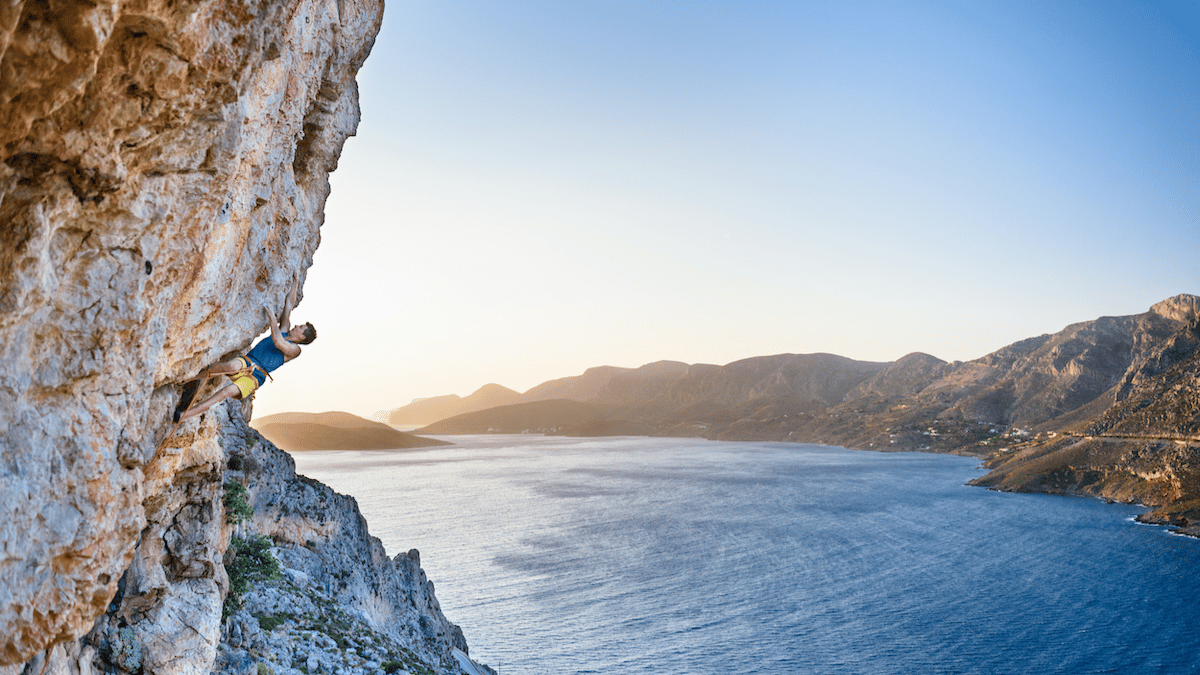Does Greece Have The Best Rock-Climbing Worldwide?
Greece is famous for its excellent rock climbing spots, especially the island of Kalymnos, known globally for having over 4,400 climbing routes and around 200 new ones being set up every year.
While Kalymnos is the most popular climbing area in Greece, there are other places that are just as exciting. Here are a few mentioned in Chapter 1:
Leonidio in the Peloponnese has recently become a favorite for climbers, with its beautiful red limestone cliffs and a variety of routes for all levels.
Meteora is known for its unique rock formations and ancient monasteries on top of them. Climbing here is limited to certain areas to preserve the monastic community.
Crete, the largest Greek island, offers climbing experiences similar to Kalymnos with its rugged limestone cliffs and beautiful scenery. It's different from Kalymnos, Leonidio, and Meteora and is featured in Mapo Tapo’s “The Climbing Travel Guide”, a book that showcases 50 of the best lesser-known climbing destinations worldwide. This guide is filled with over 150 beautiful photos and details about more than 1000 climbing spots, emphasizing areas where climbing can benefit the local community.
So, is Greece the ultimate climbing destination? While that might depend on personal opinion, you can expect to find a fantastic combination of challenges and scenic beauty that's rare elsewhere. Whether it’s the diverse routes in Kalymnos, the breathtaking views in Leonidio, or the historic sites in Meteora, Greece stands out as a top choice for climbers. Many who have traveled with Mapo Tapo believe Greece could be the best climbing spot in the world, especially if you’re looking for more than just a typical climbing experience.
In the following chapters, we will discuss about:
Where To Start Your Greece Climbing Adventure: Kalymnos, Leonidio, Meteora or Crete?
Things to know before going on a climbing Adventure To Greece
Costs and Budgeting for Climbing in Greece
Cheapest ways to get to Kalymnos, Leonidio, Meteora and Crete
Concluding Thoughts
Chapter 1: Where To Start Your Greece Climbing Adventure: Kalymnos, Leonidio, Meteora or Crete?
Greece isn't just for those who love history or the beach. In this chapter, we will look at four great climbing spots in Greece, starting from the most popular to the least known: Kalymnos, Leonidio, Meteora, and Crete.
Kalymnos Climbing: Accessible, Playful and… On A Budget
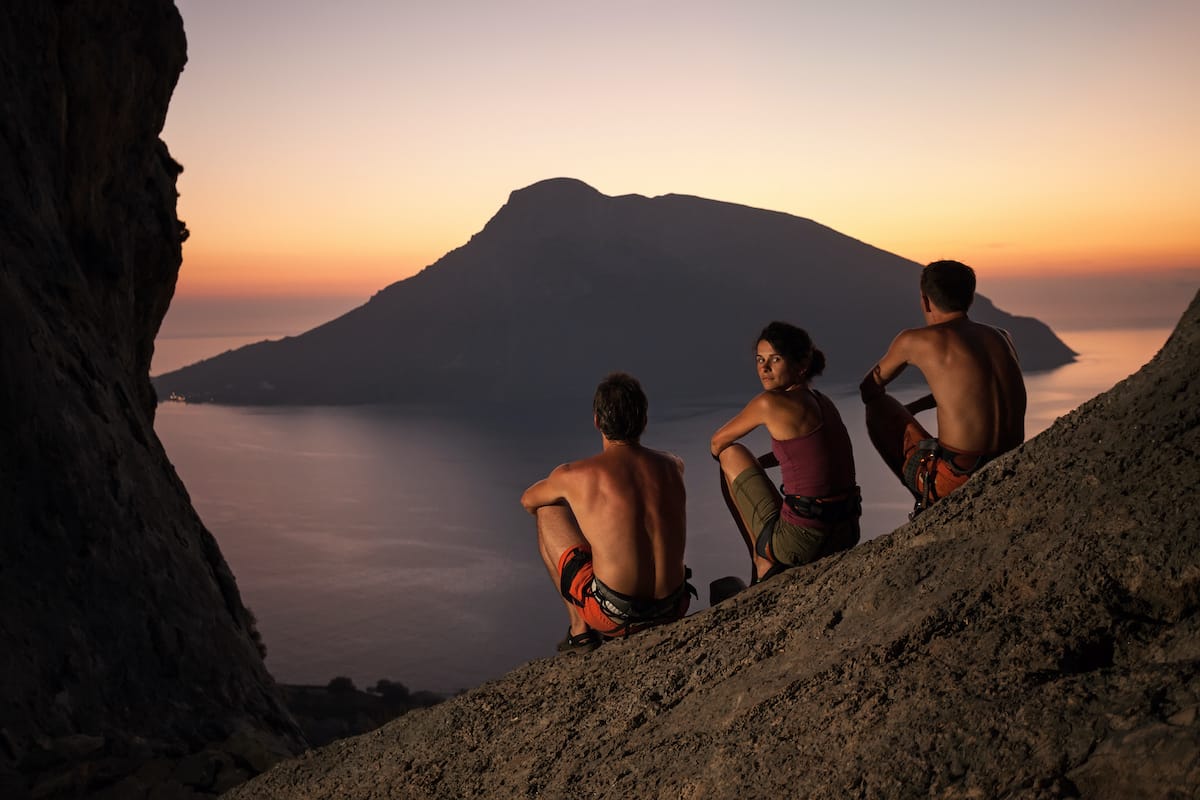
Kalymnos is famous for its top-notch rock climbing and has many routes suitable for climbers at all levels. It’s known for being easy to get to, fun to climb, and not too expensive, making it a top choice for climbers.
💡 About 2400 routes (55%) on Kalymnos are graded up to 6b+, making it ideal for new climbers, older climbers, or those transitioning from indoor to outdoor climbing.
The climbing routes in Kalymnos vary widely in difficulty, and they use the French grading system to classify them. About 25% of the routes, around 1000, are rated between 6b+ and 7a+, which is great for climbers who want to improve their skills. For those who like tougher challenges, there are more than 880 routes rated 7b and above. The toughest route confirmed on Kalymnos is rated 9a. Called "Los Revolucionarios" at sector Odyssey, it was successfully climbed by Adam Ondra in 2009.
Kalymnos has climbing spots that range from beginner-friendly areas to spots that test even the most experienced climbers, offering a mix of slabs, vertical and overhanging walls, and large caves. Some popular areas for beginners include:
Arginonta Valley: This area has over 660 routes up to 6b+ and is easy to get to, with just a five-minute walk uphill. The sector “Sea Breeze” is perfect for beginners and mid-level climbers, offering about 130 routes with beautiful views and a short walk from the parking area. Most routes here are slabs and walls, and you’ll often need an 80m rope. There are about 90 easier routes, while the rest are more challenging and vary in terrain and height.
Secret Garden in Palionisos: This crag stays shaded all day and has steep routes with 50 excellent climbs rated between 6b+ and 8b+. There are also a few easier routes up to 6b, but the rock is becoming smooth and can be slippery when humid.
The Great Cave (Grande Grotta) is not only the most popular crag in Kalymnos but also in all of Greece. It’s not suitable for all climbers, as most of its routes are very challenging and the rock is quite worn, but it’s still worth visiting. It offers about 20 challenging routes on very steep, complex terrain.
💡 These areas offer a variety of beginner-friendly routes, with well-bolted climbs and stunning views. Additionally, Kalymnos is known for its supportive climbing community, making it an excellent destination for beginners looking to improve their skills and meet other climbers.
One of the biggest advantages of climbing in Kalymnos is how affordable it is. The local community welcomes climbers, with many businesses offering discounts. You can find places to stay starting at about €30 per night for two people. There are also climbing camps and courses for beginners, priced around €350 for a week, not including flights, transportation, meals, accommodations, and personal insurance. Additionally, tour operators like Mapo Tapo often organize group climbing trips to Kalymnos for around 990€.
For more detailed information about climbing in Kalymnos that isn't covered here, make sure to check out this blog post. If you're considering a climbing trip to Kalymnos, it's a great resource.
Leonidio is Greece’s New Climbing Gem
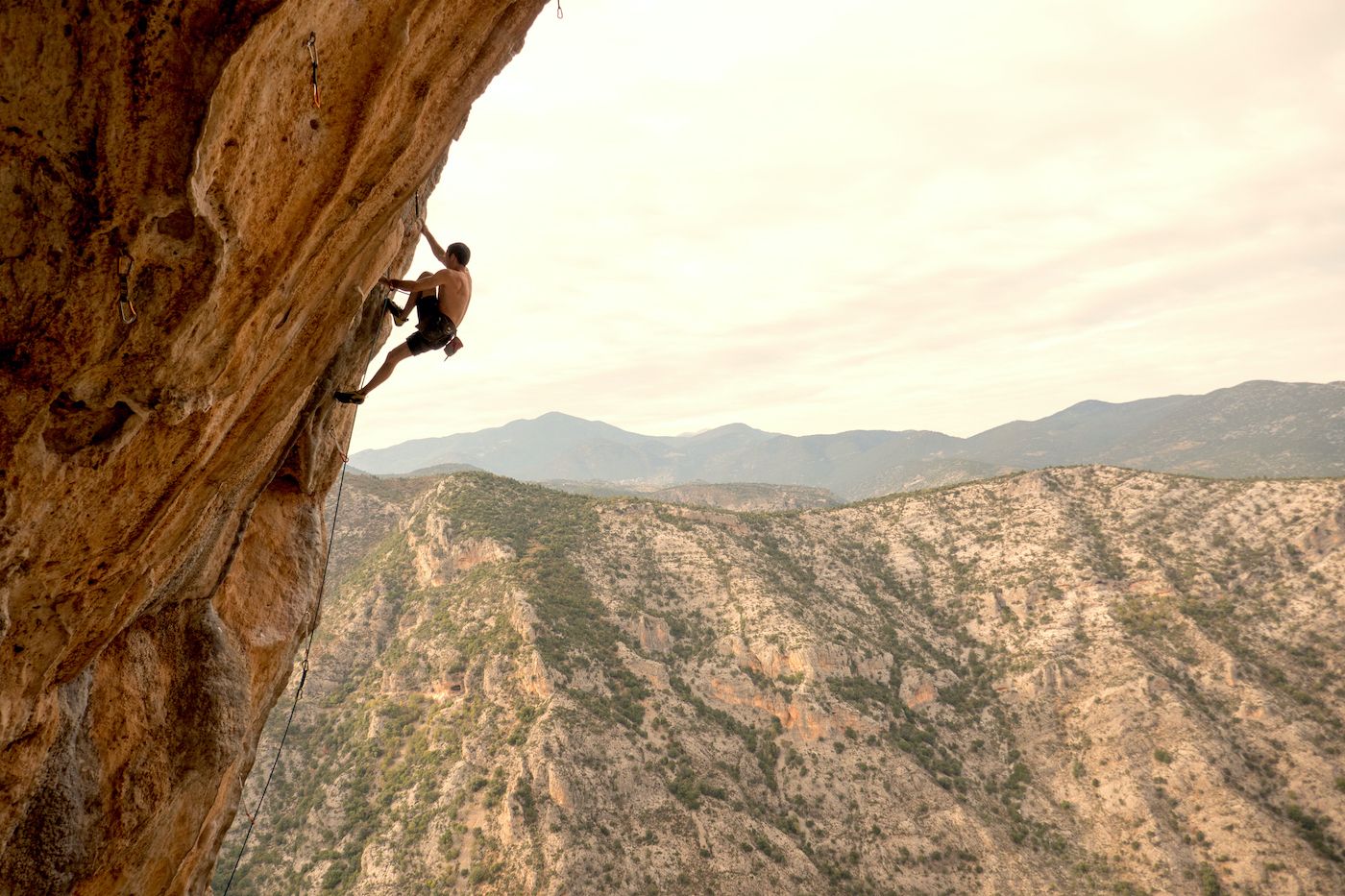
Leonidio is a newer climbing location that offers a strong cultural appeal, which Kalymnos doesn’t focus on as much. Although its climbing scene is more recent, Leonidio already boasts over 2,500 routes and hosts an annual Climbing Festival that encourages cultural exchange and community building.
💡 With 700+ climbing routes up to 6b+, 600 routes from 6c to 7a+ and 600 routes from 7b and above, both beginners and more experienced climbers will find their dream routes.
The climbing routes in Leonidio suit all skill levels, from beginners to advanced, and there are 40 multi-pitch routes available. Based on our experience, here are some recommendations for crags, depending on your climbing ability:
Panagia and its four subsectors (Panagia Cave, Mad Wall, Piccolo Muro, Yellow Wall) have well-placed bolts and unique characteristics. Beginners will find about 30 routes up to 5c+ and 20 routes between 6a and 6b+, while more advanced climbers can tackle another 30 routes of 6c and harder.
For groups with a mix of skill levels, the Yellow Eyes crags are ideal: this newer crag in Dafnon Valley offers about 50 solid, steep wall and grey slab climbs that cater to both novices and experienced climbers.
Leonidio’s most popular crags, Twin Caves and Mars, are visually stunning but cater more to advanced climbers, with most routes rated 7a and above. They are definitely worth visiting, even just for the view!
Why Leonidio stands out as Greece's new climbing gem goes beyond its excellent routes. The town, set along the Arcadian Coast, features beautiful scenery, warm locals, and a rich cuisine that showcases thousands of years of Greek culture. The climbs here offer a fun mix of tufas, pockets, steeps, and slabs with mostly short approaches.
Leonidio is still a quaint, relatively quiet village that offers an authentic Greek experience. The local food is predominantly Greek, featuring delicious eggplant dishes, olives, oranges, cheeses, seafood, and fresh produce. The town's relaxed and welcoming atmosphere makes it an ideal place to relax and enjoy your climbing trip.
Meteora Climbing Will Blow Your Mind: Sport-Climbing and Multi-Pitch
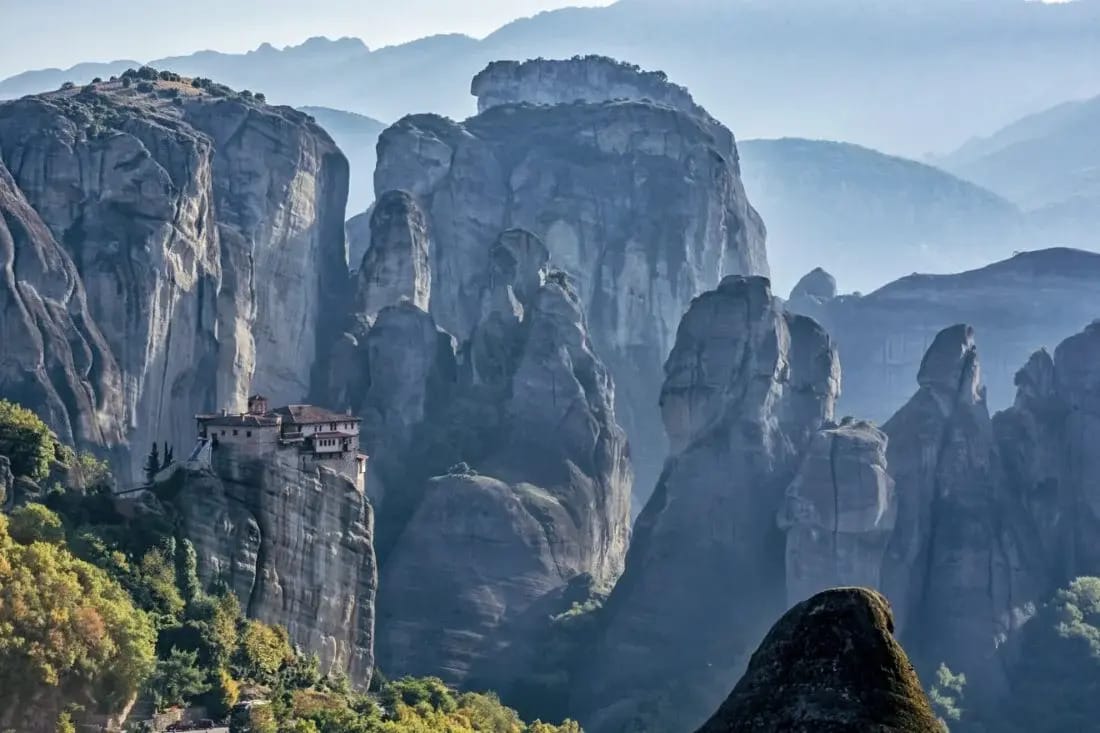
Photo © Just A Pack
If you've seen the James Bond movie "For Your Eyes Only," you might remember the incredible scenes where James Bond climbs up tall rock towers with monasteries on top. These towers have small ledges and caves, some of which were once homes to hermits. This is a good way to picture Meteora, a climbing area in mainland Greece, in the Thessalia region.
💡James Bond wasn’t the first to climb these pillars, though. The first to climb these rocks were shepherds who brought their sheep up to the top to graze, helping them survive.
The climbing routes in Meteora are unique because they blend physical climbing with a deep respect for culture, which is something you don’t find as much in places like Kalymnos and Leonidio. Many of the routes are suitable for most climbers, with about half of them being easier, up to a difficulty of 6b+. If you're climbing harder than that, there are still plenty of exciting, less-traveled routes to try on the mostly vertical and smooth terrain.
If you’re into sport climbing, nearby areas like Theopetra, Pyli, and Mouzaki have well-secured routes on high-quality limestone and even a small, unusual sandstone bouldering area. These places tend to have steep climbs that include smooth rock and tufa formations.
In Meteora, you’ll find over 900 multi-pitch and single-pitch routes across more than 170 rock pillars. These make climbing here feel like something out of a fairytale.
💡 Usually, the area is divided in 4 sectors - the Northern, Wester, Southern and Eastern Group of Pillars.
The rock formations in Meteora are unlike anywhere else in Greece or Europe, giving climbers a truly unique experience. The climbing can feel quite adventurous, with longer gaps between secure points, and bolts that are hard to spot. Sometimes the rocks have loose stones, making it tricky to secure your gear. You might need a full set of traditional climbing gear for some routes, while others only require some quickdraws. Using thin slings to tie off pebbles for extra support can often be helpful.
💡 The Meteora rock is a mix of various sized stones set in sandstone. At first glance, the rock seems quite fragile, and early climbers often felt like they were climbing on something as delicate as eggs!
However, over the past 10 years, the rock has become more stable. Frequently climbed routes have had loose rocks removed by climbers, and the natural paths of water have helped clear unstable stones. But be cautious, especially after it rains, as the rock can become more fragile.
The most popular areas for rock climbing in Meteora, Greece, include the following:
Ostkante (Pantocrator's Ridge/East Ridge) on Doupiani Rock: This is one of the most accessible routes in Meteora. It’s just a 10-minute walk from the center of Kastraki village, or you can drive and park just 30 meters from the start of the climb.
Meteora Pillars: These unique rock formations rise from the Plain of Thessaly and provide a challenging and picturesque setting for climbing, feeling like something from a fairytale.
Other areas in Meteora: While climbing directly on the six rock pillars with monasteries is not allowed, there are over 100 other routes available for climbers to explore. The climbing areas of Theopetra, Pyli, and Mouzaki offer well-secured sport climbs on high-quality limestone, featuring steep routes with tufas on smooth rock.
Most popular routes have two secure bolts at the top, but some still use large bolts meant for anchoring. It’s important to differentiate these from the smaller bolts used along the route. When using a single bolt for rappelling, set up your rope so you pull on the end that goes under the bolt when retrieving it, to prevent the bolt from trapping the rope.
💡 Here’s a selection of the most recent climbing guidebooks for navigating Meteora and its sport-climbing, multi-pitch and trad-climbing opportunities.
Rock Climbing in Crete: The Off-The-Beaten-Track Spot You Don’t Expect
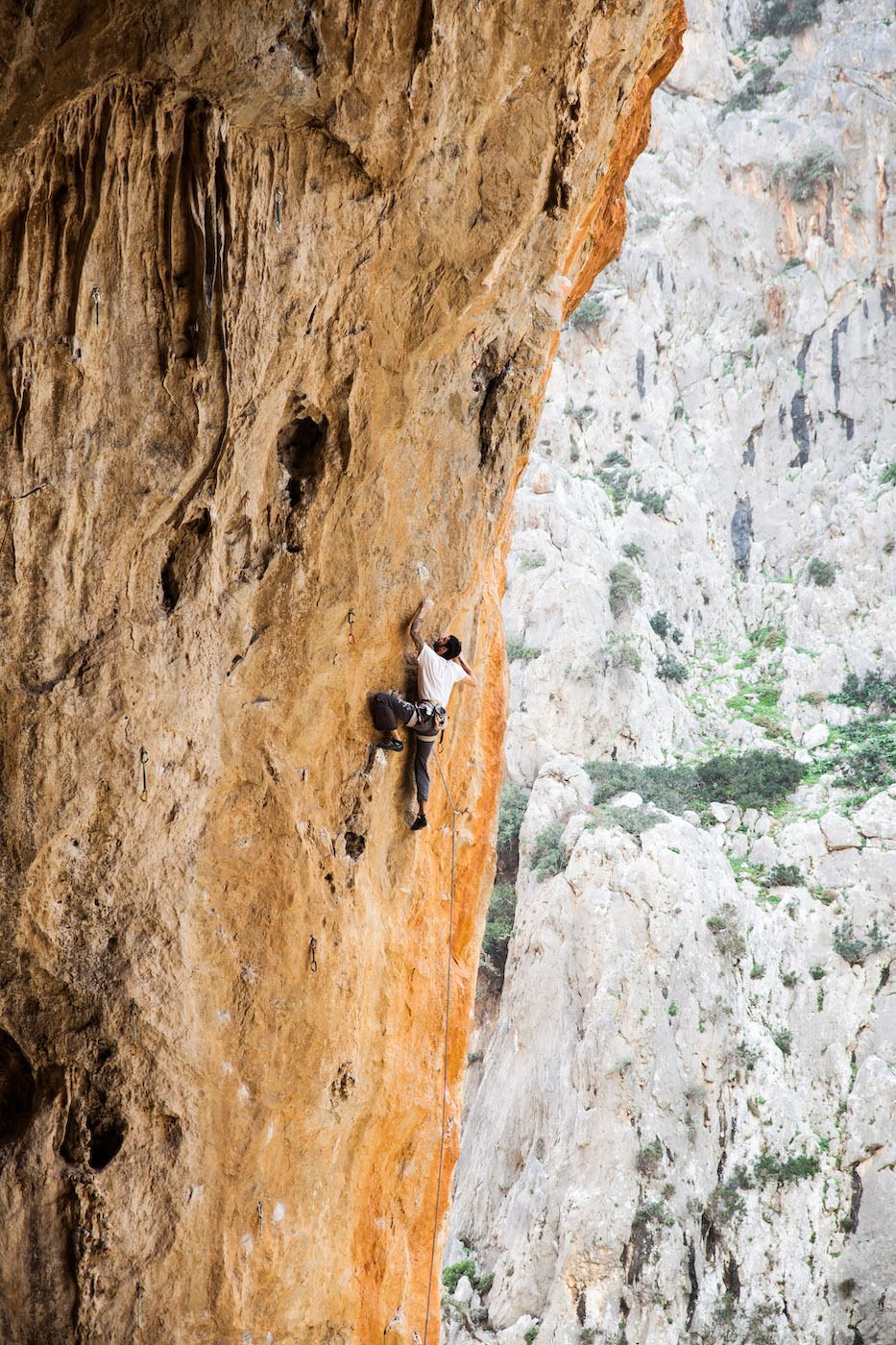
Crete is quite different from Kalymnos, Leonidio, and Meteora in how you plan your climbing trips and what you can expect. Its climbing spots are spread out across the island, offering a variety of adventures that require more travel. Crete's climbing includes both traditional sport routes and unique spots for cliff diving into the water, appealing to those who love exploring and finding hidden spots. Unlike Kalymnos, where you can easily walk between climbing spots, Crete blends climbing with other outdoor activities, such as hiking and visiting beaches.
Crete has become one of the top climbing destinations in Europe, with a variety of landscapes that offer many different types of climbing. You can find routes through limestone areas, caves, and even marble, all with interesting rock formations.
Crete’s mild weather allows for climbing all year round, making it perfect for climbers who want to stay active no matter the season. Plus, the friendly locals and great food make longer climbing trips very enjoyable. Here are some key climbing spots in Crete:
Agiofarago Beach: Located near the village of Kaloi Limenes, Agiofarago offers a quiet and beautiful climbing area that was once a retreat for hermits. Now, it has over 200 sport climbing routes along a steep limestone gorge that leads to the sea. The rock quality is excellent, with most routes being vertical or slightly leaning back. For those interested in cliff diving, there are several sea caves that provide safe jumps into the water, making Agiofarago a stunning place to climb.
Plakias: Two hours west of Agiofarago, Plakias is a beach town with a large, sheer grey limestone cliff that has about 30 sport climbing routes. These routes range from easy to very difficult and require precise climbing on small holds. The cliff faces northwest, allowing for climbing in warmer weather and a swim in the sea afterward.
Therissos and the Therissos Gorge: Near Chania, in the shadow of the White Mountains, Therissos offers around 50 bolted routes in a beautiful gorge. The area has a variety of climbs, including some beautiful pitches full of rock features. It's easy to get to the climbing spots because there's a paved road through the gorge, and the area's slightly higher elevation makes it a good spot for summer climbing.
Mount Giglios: For a more traditional and adventurous multi-pitch climbing experience, Mount Giglios has routes up a 1,000-meter tall wall of grey limestone. The rock varies in quality, but the routes are rewarding for their adventurous nature and the views they offer.
Tersanas Cave: On the Gramvousa Peninsula, Tersanas Cave is similar to the Grande Grotta in Kalymnos. This large cave has 20 long routes on slightly overhanging rock filled with tufas and stalactites, ending in a challenging horizontal roof. The climbing here is tough, with widely spaced bolts and a steep approach, but the views are incredible.
In summary, Crete offers a diverse range of climbing opportunities, pleasant weather, stunning scenery, and welcoming locals, making it a top destination for climbers.
Chapter 2: Things to know before going on a climbing Adventure To Greece
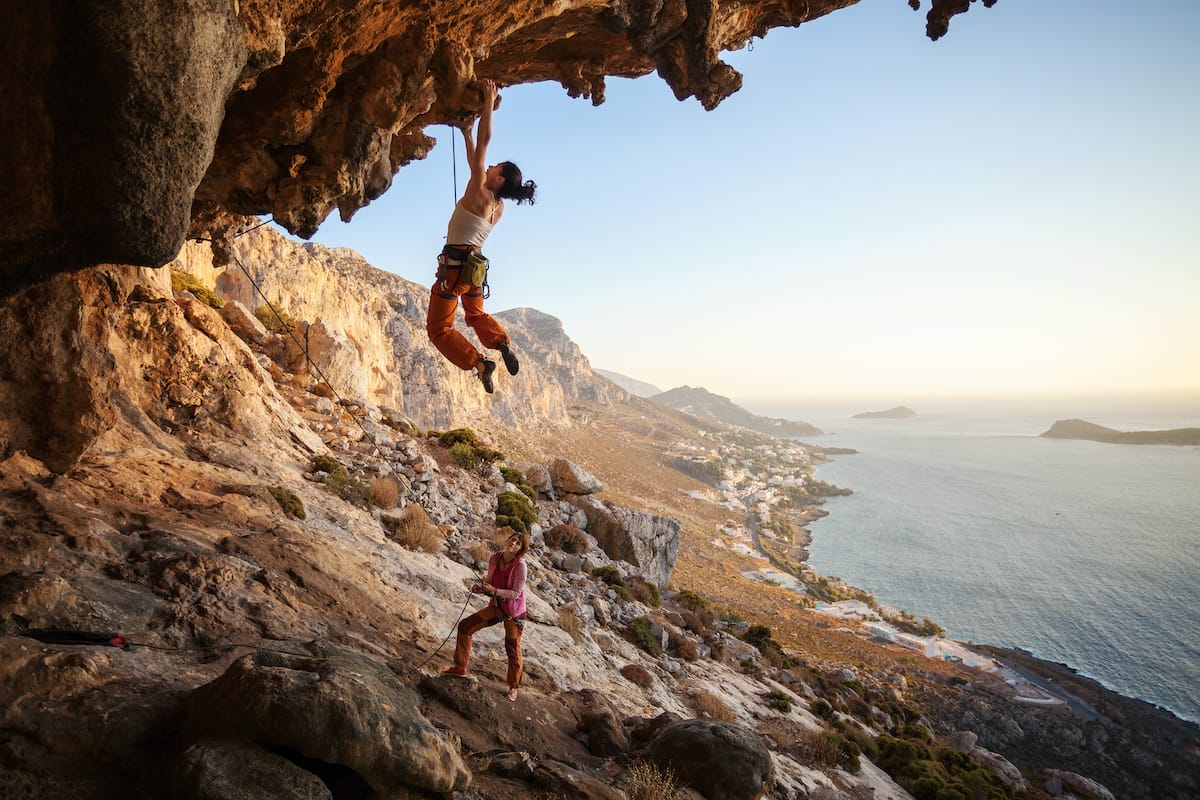
Kalymnos: Popularity Has Downsides
Climbing in Kalymnos is incredible, but it comes with its challenges. The island is famous for its steep climbs, so climbers should be comfortable with steep terrains. Most of the climbing here involves gripping onto tufas—rounded, chunky rock formations that jut out—which are fun but can be tough to hold onto because they're so worn down from lots of use, making them slippery and more difficult to climb.
Also, this destination might not suit beginners as much because it heavily focuses on this specific type of climbing. However, for more skilled climbers looking for a variety of climbing styles, they might find it a bit limiting. Still, the island has countless climbing options, no matter what your skill level.
Leonidio: Accessible, Open to All Climbing Levels… and beyond
Leonidio is growing as a climbing destination because it’s easy to reach. Many climbers fly into Athens and drive or take a bus to Leonidio, which is only about 3.5 to 4 hours away. Some even drive their own vans or rental camper vans to stay longer.
Besides climbing, there's a lot more to see and do in Leonidio. You can visit the Elona Monastery, explore the traditional mountain village of Kosmas, or drive down to Monemvasia, a beautiful medieval castle town. Leonidio is also a great place to try authentic Greek food at local taverns and restaurants, even if you're on a budget.
Seasonality: Good Climbing Conditions or Warm Waters?
Deciding when to climb in Greece’s top spots—Kalymnos, Leonidio, Meteora, and Crete—often means choosing between perfect climbing weather and the tempting warm seas.
In Kalymnos, the best times to climb are spring (April to June) and fall (September to October) when the weather is mild and the areas less crowded. Leonidio is great from November to April because its cliffs provide shelter from the bad weather, making it perfect for winter climbing. Meteora is best during the cooler days of spring or the early warm days of fall to avoid the rainy season. Crete’s mild climate allows for climbing all year, but the best time is from October to April, although summer climbing is still possible.
However, climbing during the hot summer months in these areas can be tough with sweaty climbs and slippery rocks. But there are cooler, shaded spots like the Sikati Cave and the Secret Garden in Kalymnos, or higher altitudes in Meteora and Crete where climbing is more comfortable. In Crete, the Voulismeno Aloni crag offers a variety of climbing styles and beautiful sea views, and it’s good for climbing any time of the year.
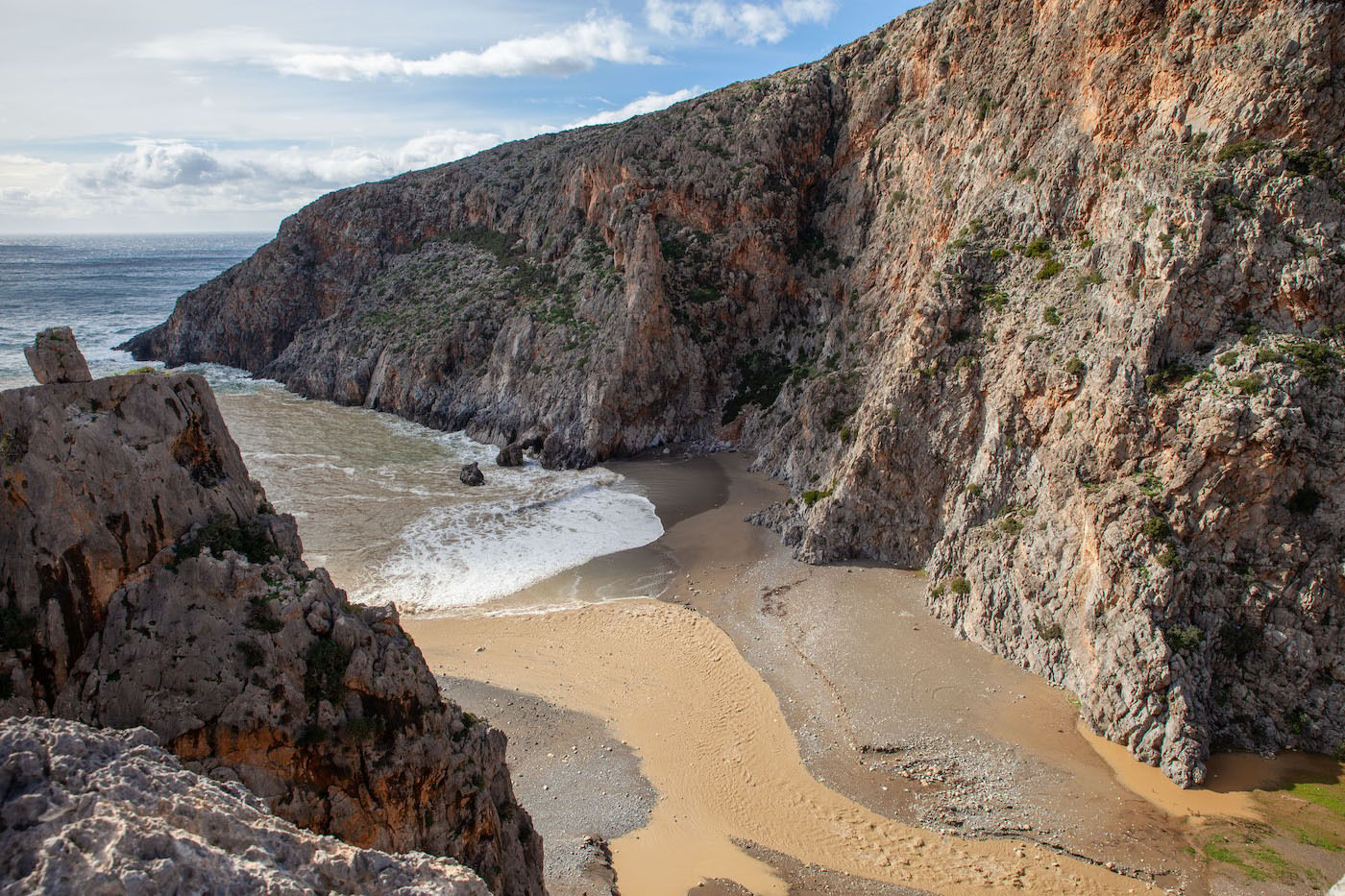
Meteora: Ethics, Religion, and Multi-pitches
Meteora offers a unique climbing experience filled with historical and spiritual depth, quite different from the sport climbing found in Kalymnos and Leonidio. The climbing at Meteora mainly involves multi-pitch routes and comes with more restrictions, both in terms of the climbing itself and access due to the area's religious importance.
Most climbing routes here have permanent anchors, but you might still need to bring your own traditional climbing gear like nuts and camming devices for some climbs. It’s a good idea to bring twin 60m ropes and a set of traditional gear to fully enjoy what Meteora has to offer.
Climbing these multi-pitch routes in Meteora is generally safe, but you should always focus on safety and follow best climbing practices. The climbing routes here are unique and challenging, often requiring a strong commitment and rewarding climbers with incredible views. Since German climbers originally developed the area, you should expect to find some long stretches between secure points, known as run-outs, which are part of the local climbing ethics to reduce rope drag.
In Meteora, you can’t add new bolts, so be prepared to use slings for additional safety. The type of rock here works well with slings, but you need to be careful and make sure you have the right skills and equipment for multi-pitch climbing. Be mindful of the varied terrain, which can include vertical and slabby sections with loose pebbles, as well as the weather and your own climbing abilities, to ensure a safe and enjoyable experience in Meteora.
Chapter 3: Costs and Budgeting for Climbing in Greece
Guiding Fees
Navigating the cost of guided climbs in Greece and using smart money-saving strategies can help you understand how much you'll pay for guided climbing tours. As of 2024, you can expect to pay between €80 to €600 in guiding fees, depending on how long your climbing trip is:
Half-Day (4 hours): For a small group of 1-3 people, the fees range from €200 to €300. If your group has four or more climbers, the cost per person drops a lot, to €50.
Full Day: The cost for a small group of 1-3 people is between €350 and €450. For larger groups, the cost per climber is reduced to between €100 and €150, which makes it more cost-effective to climb in a group.
Group Climbing Courses: If you're interested in more in-depth learning, one-day courses are available for about €200 per person for groups of 3 or more. Three-day courses can cost between €400 to €500, and extensive five-day courses are around €600.
These rates show that forming larger groups or climbing during less busy seasons can save you a lot of money. By joining guided group trips, you can both enjoy your climb more and save money.
Climbing Houses, Accommodations, and Camping
Kalymnos: To save on lodging, consider staying in hostels or budget-friendly hotels, such as:
Spongia Apartments Kalymnos: Prices start at around €60 per night, offering a highly rated and affordable option for climbers.
Sunset: Another budget option with a rating of 9.2, providing a comfortable stay at a reasonable price.
Valentino: With a rating of 9.2, Valentino offers budget-friendly accommodation for climbers looking for quality places to stay at an affordable price.
In Kalymnos, accommodation prices start at about €30 per day for two people. Studios, which typically include a double room with a private bathroom, start at about €20 per day depending on the season.
Leonidio: Consider budget-friendly accommodations in Leonidio, especially during the off-season or for longer stays:
Hotel Hatzipanayiotis is a beautiful and affordable rustic hotel with rooms for 1-4 people.
Climb2red Studio offers a highly rated studio apartment with rooms for 1-2 people, located near the climbing areas.
Staying in these places typically costs between €30-80 per night. They are generally affordable and provide a comfortable place to stay during a climbing trip in Leonidio. It’s best to book early, especially during the peak season, to ensure availability.
Meteora: Kastraki, near the famous Meteora climbing sites, offers various budget-friendly accommodation options suitable for climbers. Options include:
Guesthouses and B&Bs: These offer affordable rates and often include breakfast.
Hostels: Perfect for budget travelers, providing basic amenities and shared rooms.
Camping: A cost-effective choice, with facilities providing the essentials for a comfortable stay.
Monasteries: Some offer rooms to travelers for a small donation, providing a unique and economical lodging option.
Crete: There are many budget-friendly places to stay in Crete, such as hostels, guesthouses, or apartments. Examples include:
Pergola, located in Agios Nikolaos, offering rooms for €49 per night.
Argyro Rooms, located in Kritsa, also offers rooms for €49 per night.
Joining a budget-friendly climbing tour can also help reduce costs, including accommodation, transportation, and climbing equipment. Careful planning and research are essential for a budget-friendly climbing trip in Crete. Look for affordable options for flights, ferries, accommodations, and climbing tours.
Total Costs and Group Trips Costs
For a 7-day guided climbing trip in Greece, prices vary from €1,000 to €2,500 per person depending on the location. Kalymnos tends to be a bit pricier than other Greek climbing spots. These packages usually include your stay, a professional guide, climbing lessons, and different types of rooms. It's best to visit during spring or fall when the weather in Greece is great for climbing and prices are lower.
For example, a 7-day climbing trip to Kalymnos costs around €1,300 for one person, €2,300 for a couple, and about €4,000 for a group of four. But you can cut costs significantly by following some money-saving tips. You might also consider joining a group trip, which could be cheaper, especially since flight costs are not included.
A week-long climbing holiday in Leonidio typically costs between €770 and €1,200 per person. This price includes six nights in an apartment with double rooms. Leonidio offers plenty of budget-friendly accommodation options like apartments and guesthouses that are both comfortable and well-equipped.
While some climbing packages are luxurious and more expensive, there are also more affordable options available that support local businesses and climbing communities, making climbing in Greece accessible to climbers on different budgets.
Expense | Traveling from EU | Traveling from extra-EU |
|---|---|---|
Flights (round-trip) | €250 | €1,200 |
Accommodation (6 nights) | €180 | €180 |
Guiding fees (per person, group of 4) | €600 | €600 |
Rental car (7 days) | €200 | €200 |
Local transport | €100 | €100 |
Total | €1,330 | €2,280 |
Chapter 4: Cheapest ways to get to Kalymnos, Leonidio, Meteora and Crete
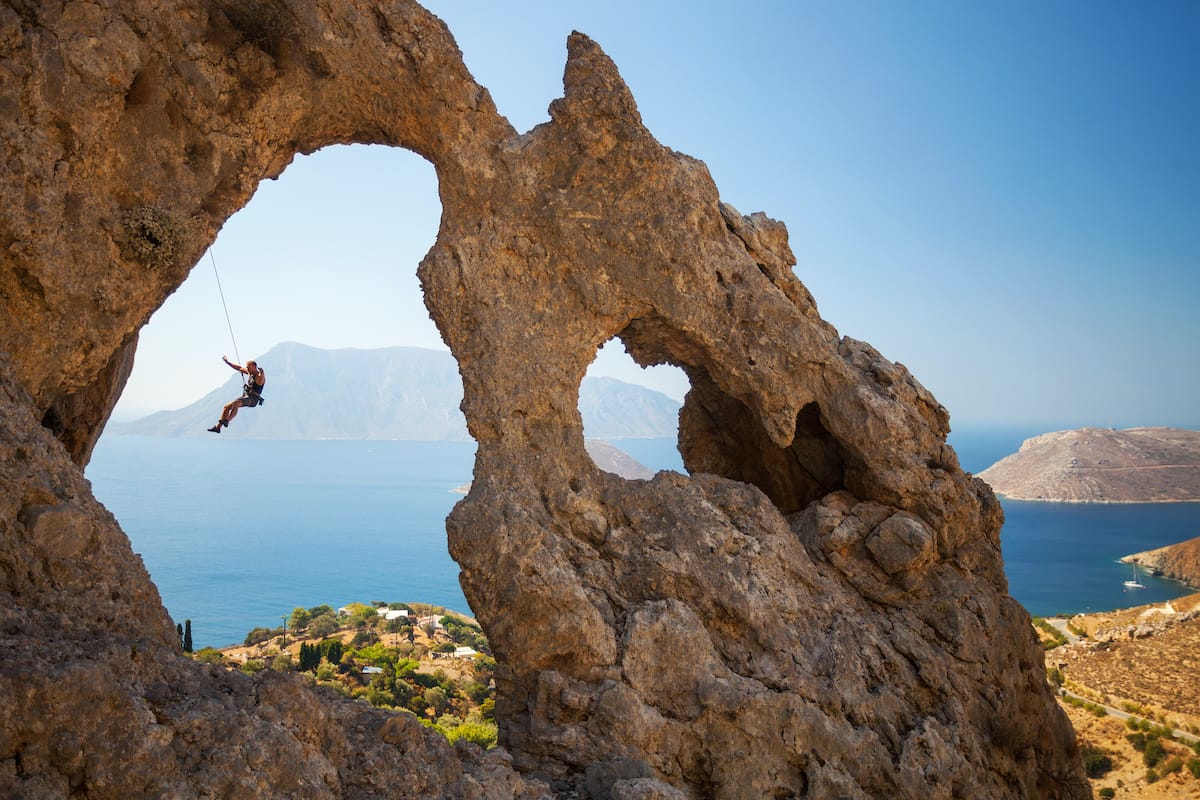
How to Get to Kalymnos for climbing… on a budget
To climb in Kalymnos without spending too much, follow these steps:
Fly to Rhodes Airport, a major travel hub in Greece that often has low-cost flights from European cities like Milan or London, with prices ranging from €50 to €200. If you're flying from New York, expect to pay between €300 and €1,400.
Take a ferry from Rhodes to Kalymnos, which costs about €8 to €10 per person.
Once in Kalymnos at Pothia port, take a taxi to Masouri for around €15-16. Alternatively, you can rent a scooter or a car right at the port.
Most climbers choose to stay in climbing villages like Armeos, Masouri, and Myrties on Kalymnos's west coast, where many climbing sites are within walking distance. For a more authentic local experience, consider staying in less touristy villages like Panormos, Kantouni, Linaria, or Platis Gialos.
How to Get to Leonidio for Climbing on a Budget
Reaching Leonidio is straightforward:
Fly to Athens Airport, the closest major airport.
Drive or take public transport from Athens to Leonidio, which takes about 3.5 to 4 hours. You can rent a car at the airport or catch one of the buses that run to Leonidio twice a day.
How to Get to Meteora for Climbing on a Budget
To reach Meteora affordably, consider these options:
By car: Drive from Italy to Greece via ferry to Igoumenitsa and then to Meteora. This allows you to bring all your climbing gear but can be pricier than other methods.
By plane and car: Fly to Athens and rent a car to drive to Meteora. This gives you flexibility but might be more expensive than public transport.
By bus: Buses run from both Athens and Thessaloniki to Meteora, offering a cheaper alternative to car rental.
By train: Trains from Athens and Thessaloniki go to Kalampaka, the closest town to Meteora, and tend to be cheaper and potentially more convenient than buses.
In Meteora, you can walk to many climbing routes from the village of Kastraki, where most climbers stay. Approaches are generally short, often taking just 15 to 20 minutes.
How to Get to Crete for Climbing on a Budget
For an economical climbing trip to Crete, you can:
Fly to Crete: Search for low-cost flights via budget airlines like Ryanair, EasyJet, or Wizz Air. Comparing prices from different airports may help find cheaper options.
Take a ferry: Ferries from mainland Greece to Crete can be more affordable than flights but are slower. Check for deals and schedules from ports like Piraeus, Rafina, or Heraklion.
Rent a car in Crete: This allows for easy access to various climbing sites and can be economical, especially if splitting the cost with others. Rental prices vary by season but are generally reasonable compared to other locations in Greece.
These tips can help you plan a memorable climbing adventure in Greece while keeping costs down.
Chapter 5: Concluding Thoughts
From the steep, challenging routes in Kalymnos to the more accessible climbs in Leonidio, the significant multi-pitch routes in Meteora with their spiritual history, and the all-year climbing in Crete, Greece caters to climbers of all levels.
As highlighted in earlier chapters, preparation is crucial. Each climbing area in Greece has its own characteristics and challenges. Whether it's dealing with the steep rocks of Kalymnos, considering the best season to visit, respecting the sacred traditions in Meteora, or managing your budget, being well-prepared is vital for a great climbing trip.
Understanding the costs associated with guided climbs, accommodation, and travel will also help you plan a cost-effective trip. Smart planning allows you to enjoy the best of Greek rock climbing without overspending.
Greece, with its breathtaking views, rich climbing culture, mild climate, and friendly communities, is a top destination for climbers worldwide. Whether you are an experienced climber or just starting, Greece offers diverse climbing experiences that will make your trip unforgettable.

